1988 PONTIAC FIERO transmission
[x] Cancel search: transmissionPage 1032 of 1825

MANUAL LO
CONVERTEM CLUTCH - RELEASED
FORWARD CLUTCH - APPLIED
Maximum downhill braking can be obtained at speeds below 30 mph (48 kmlh) with the selector
in Lo (tat) range. Lollst oil pressure, which is 1206 kR I175 psi), is the same as second (2nd) oil pressure
because second (02) oil is still present.
Lo oil from the manual valve is directed to the following:
1* 1-2 Shift Valvelain
2. to and Reverse Clutch
3. Lo Overrun Valve
Lo oil at the 1-2 T.V. valve combined with the 1-2 throttle valve spring force will close the 1-2 shift
valve at speeds approximately 36 mph 156 km/h) or below. This allows 2nd oil to exhaust, releasing
the 2-4 band, and lo oil to apply the lo and reverse clutch.
Loflst oil coming off the 1-2 T.V* valve is directed toward the lo overrun valve that regulates lolreverse
oil. This smoothes the 2-1 manual downshift for maximum engine braking.
The forward clutch is applied. The lo and reverse, and the overrun clutch are applied to allow engine
braking.
The 2-4 band is released, the transmission is in Lo Range - First Gear.
HYDRAULIC DIAGNOSIS 700-RU3
OVEARUM CLUTCH - APPLIED
LO ROLLER CLUTCH - APPLIED
JH018&7WR4
Figure 40 Manual Lo
Page 1034 of 1825

HYDRAULIC DIAGNOSIS 700-84-45
REVERSE
REVERSE INPUT CLUTCH - APPLIED
LO AND REVERSE CLUTCH - APPLIED
When the selector lever is moved to the Reverse (R) position, the manual valve is repositioned to allow
line pressure to enter the reverse passage which directs oil to the following:
1. Lo and Reverse Clutch
2. Reverse Input Clutch
3. Reverse Boost Valve
4. Lo Overrun Valve
Reverse oil is
orificed at the retainer and ball assembly, and regulated at the lo overrun valve to apply
the lo and reverse clutch.
Reverse oil is
orificed into the reverse input clutch and orificed out of the reverse input piston for a
smooth apply of the reverse input clutch during the shift.
Reverse oil acting on the reverse boost valve in the pressure regulator will boost line pressure to
approximately 670
kPa (100 psi). M.T.V. oil from the line bias valve acting on the T.V. boost valve,
in the pressure regulator, will further boost line pressure from 670
kPa (100 psi) at idle to 1690 kPa
(245 psi) at full throttle.
The reverse input clutch is applied. The lo and reverse clutch is applied. The transmission is in
Figure 42 Reverse
Page 1050 of 1825
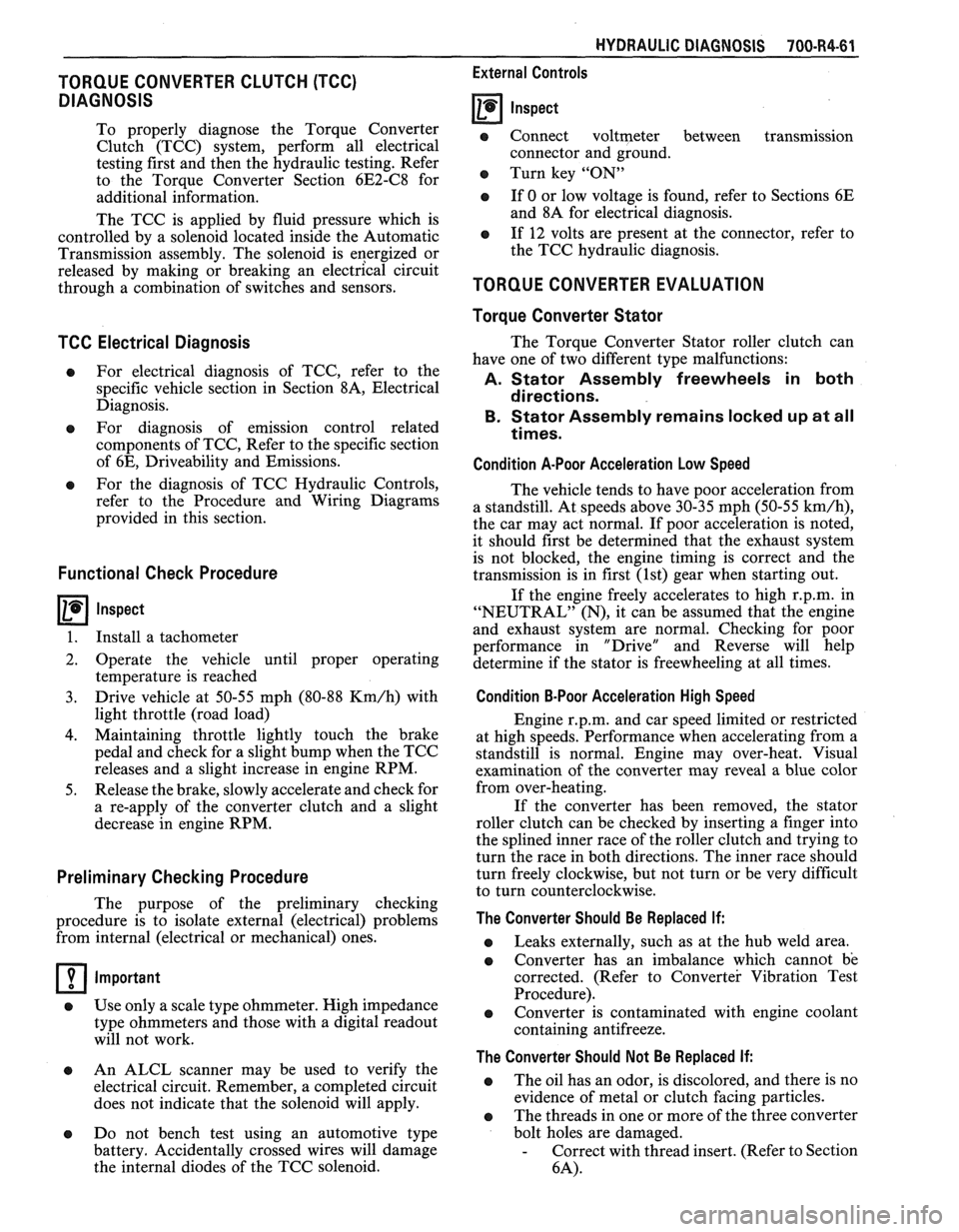
TORQUE CONVERTER CLUTCH (TCC)
DIAGNOSIS
To properly diagnose the Torque Converter
Clutch (TCC) system, perform all electrical
testing first and then the hydraulic testing. Refer
to the Torque Converter Section
6E2-C8 for
additional information.
The TCC is applied by fluid pressure which is
controlled by a solenoid located inside the Automatic
Transmission assembly. The solenoid is energized or
released by making or breaking an electrical circuit
through a combination of switches and sensors.
TCC Electrical Diagnosis
e For electrical diagnosis of TCC, refer to the
specific vehicle section in Section
8A, Electrical
Diagnosis.
e For diagnosis of emission control related
components of TCC, Refer to the specific section
of
6E, Driveability and Emissions.
e For the diagnosis of TCC Hydraulic Controls,
refer to the Procedure and Wiring Diagrams
provided in this section.
Functional Check Procedure
rn Inspect
1. Install a tachometer
2. Operate the vehicle until proper operating
temperature is reached
3. Drive vehicle at 50-55 mph (80-88 Km/h) with
light throttle (road load)
4. Maintaining throttle lightly touch the brake
pedal and check for a slight bump when the TCC
releases and a slight increase in engine RPM.
5. Release the brake, slowly accelerate and check for
a re-apply of the converter clutch and a slight
decrease in engine RPM.
Preliminary Checking Procedure
The purpose of the preliminary checking
procedure is to isolate external (electrical) problems
from internal (electrical or mechanical) ones.
Important
e Use only a scale type ohmmeter. High impedance
type ohmmeters and those with a digital readout
will not work.
e An ALCL scanner may be used to verify the
electrical circuit. Remember, a completed circuit
does not indicate that the solenoid will apply.
e Do not bench test using an automotive type
battery. Accidentally crossed wires will damage
the internal diodes of the TCC solenoid.
HYDRAULIC DIAGNOSIS 700-R4-61
External Controls
rn Inspect
e Connect voltmeter between transmission
connector and ground.
e Turn key "ON"
e If 0 or low voltage is found, refer to Sections 6E
and 8A for electrical diagnosis.
e If 12 volts are present at the connector, refer to
the TCC hydraulic diagnosis.
TORQUE CONVERTER EVALUATION
Torque Converter Stator
The Torque Converter Stator roller clutch can
have one of two different type malfunctions:
A. Stator Assembly freewheels in both
directions.
B. Stator Assembly remains locked up at all
times.
Condition A-Poor Acceleration Low Speed
The vehicle tends to have poor acceleration from
a standstill. At speeds above 30-35 mph (50-55
km/h),
the car may act normal. If poor acceleration is noted,
it should first be determined that the exhaust system
is not blocked, the engine timing is correct and the
transmission is in first
(1st) gear when starting out.
If the engine freely accelerates to high
r.p.m. in
"NEUTRAL" (N), it can be assumed that the engine
and exhaust system are normal. Checking for poor
performance in "Drive" and Reverse will help
determine if the stator is freewheeling at all times.
Condition B-Poor Acceleration High Speed
Engine r.p.m. and car speed limited or restricted
at high speeds. Performance when accelerating from a
standstill is normal. Engine may over-heat. Visual
examination of the converter may reveal a blue color
from over-heating.
If the converter has been removed, the stator
roller clutch can be checked by inserting a finger into
the splined inner race of the roller clutch and trying to
turn the race in both directions. The inner race should
turn freely clockwise, but not turn or be very difficult
to turn counterclockwise.
The Converter Should Be Replaced If:
e Leaks externally, such as at the hub weld area.
e Converter has an imbalance which cannot be
corrected. (Refer to Converter Vibration Test
Procedure).
e Converter is contaminated with engine coolant
containing antifreeze.
The Converter Should Not Be Replaced If:
e The oil has an odor, is discolored, and there is no
evidence of metal or clutch facing particles.
e The threads in one or more of the three converter
bolt holes are damaged.
- Correct with thread insert. (Refer to Section
6A).
Page 1052 of 1825
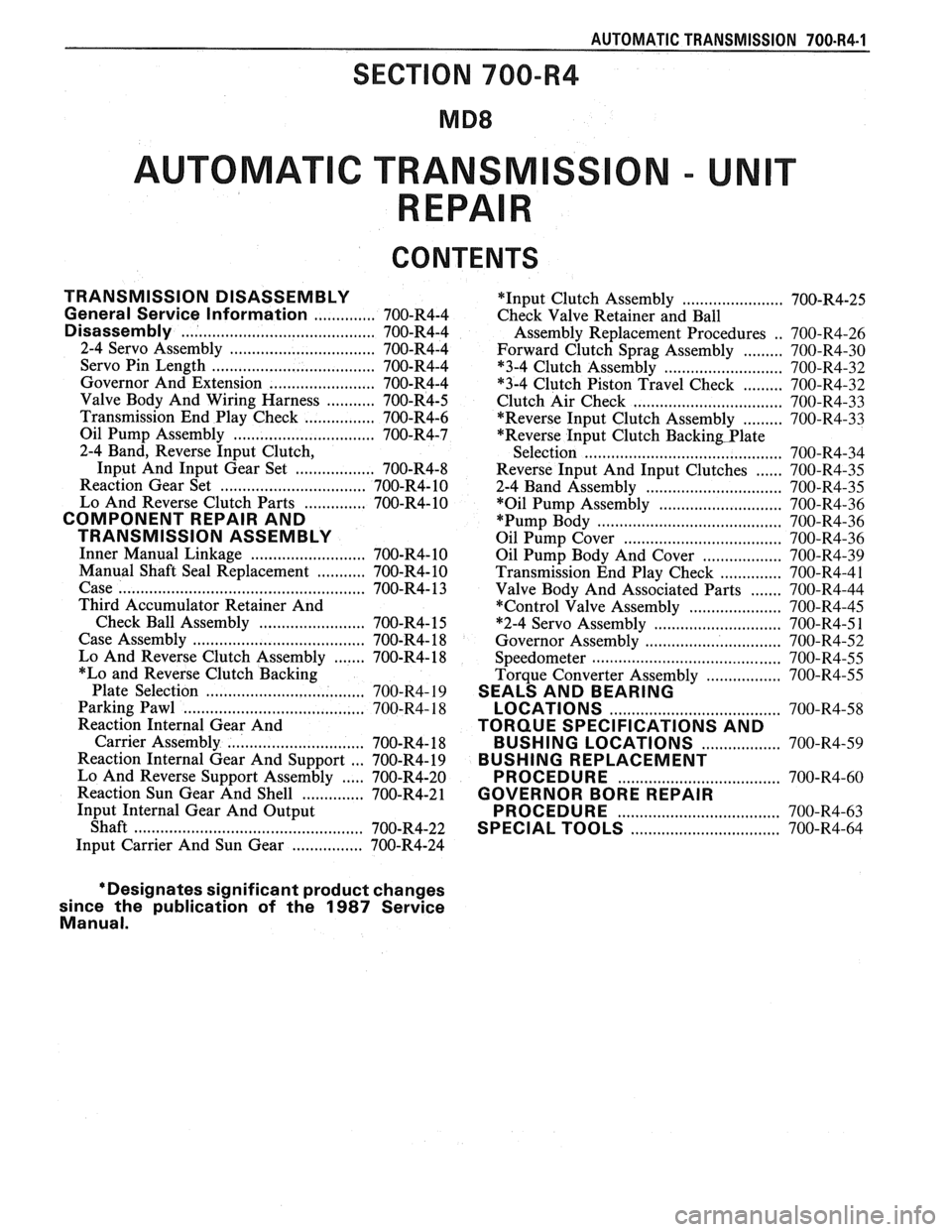
AUTOMATIC TRANSMISSION 700-R4-1
AUTOMAT C TRANSM
CONTENTS
TRANSMISSION DISASSEMBLY
.............. General Service Information 700-R4-4
........................................... Disassembly 700-R4-4
2-4 Servo Assembly
................................. 700-R4-4
.................................. Servo Pin Length 700-R4-4
........................ Governor And Extension 700-R4-4
Valve Body And Wiring Harness
........... 700-R4-5
................ Transmission End Play Check 700-R4-6
Oil Pump Assembly
................................ 700-R4-7
2-4 Band. Reverse Input Clutch.
.................. Input And Input Gear Set 700-R4-8
Reaction Gear Set
................................. 700-R4- 10
.............. Lo And Reverse Clutch Parts 700-R4-10
COMPONENT REPAIR AND
TRANSMISSION ASSEMBLY
Inner Manual Linkage .......................... 700-R4- 10
........... Manual Shaft Seal Replacement 700-R4-10
Case
...................................................... 700-R4- 13
Third Accumulator Retainer And
Check Ball Assembly
........................ 700-R4- 15
Case Assembly
............................. ., ...... 700-R4- 18
Lo And Reverse Clutch Assembly
....... 700-R4- 18
*Lo and Reverse Clutch Backing
Plate Selection
.................................. 700-R4- 19
..................................... Parking Pawl 700-R4- 18
Reaction Internal Gear And
Carrier Assembly
.............................. 700-R4- 18
Reaction Internal Gear And Support
... 700-R4- 19
Lo And Reverse Support Assembly
..... 700-R4-20
Reaction Sun Gear And Shell
.............. 700-R4-21
Input Internal Gear And Output
.................. Shaft .......................... ... 700-R4-22
................ Input Carrier And Sun Gear 700-R4-24 *Input
Clutch Assembly
....................... 700-R4-25
Check Valve Retainer and Ball
Assembly Replacement Procedures
. . 700-R4-26
Forward Clutch Sprag Assembly
......... 700-R4-30
*3-4 Clutch Assembly
.......................... 700-R4-32
......... "3-4 Clutch Piston Travel Check 700-R4-32
Clutch Air Check
................................. 700-R4-33
......... *Reverse Input Clutch Assembly 700-R4-33
"Reverse Input Clutch
Backin~Plate
Selection ...................................... 700-R4-34
Reverse Input And Input Clutches
...... 700-R4-35
2-4 Band Assembly
.............................. 700-R4-35
*Oil Pump Assembly
............................ 700-R4-36
"Pump Body .......................................... 700-R4-36
Oil Pump Cover
.................................... 700-R4-36
Oil Pump Body And Cover
.................. 700-R4-39
Transmission End Play Check
.............. 700-R4-4 1
....... Valve Body And Associated Parts 700-R4-44
*Control Valve Assembly
..................... 700-R4-45
*2-4 Servo Assembly
............................. 700-R4-5 1
Governor Assembly ............................... 700-R4-52
........................................... Speedometer 700-R4-55
Torque Converter Assembly
................. 700-R4-55
SEALS AND BEARING
....................................... LOCATIONS 700-R4-58
TORQUE SPECIFICATIONS AND
.................. BUSH l NG LOCATIONS 700-R4-59
BUSHING REPLACEMENT
..................................... PROCEDURE 700-R4-60
GOVERNOR BORE REPAIR
PROCEDURE
......................... ............ 700-R4-63
...... ...................... SPECIAL TOOLS .. 700-R4-64
*Designates significant product changes
since the publication of the
1987 Service
Manual .
Page 1054 of 1825

AUTOMAT lC TRANSMISSION 700-R4-3
ILL. NO. DESCRIPTION
1 CONVERTER ASSEMBLY
2 SEAL ASSEMBLY, OIL
3 BUSHING, OIL PUMP BODY
4 BUSHING, STATOR SHAFT (FRONT)
5 BOLT, PUMP TO CASE
6 WASHER, PUMP TO CASE BOLT
7 PUMP ASSEMBLY, OIL
8 SEAL, OIL (PUMP TO CASE)
9 GASKET, PUMP COVER TO CASE
10 CASE, TRANSMISSION
11 VENT ASSEMBLY, TRANSMISSION
1 12 CONNECTOR, OIL COOLER PIPE 13 RING, SERVO COVER RETAINING
14 SEAL, "0" RlNG
(2-4 SERVO COVER)
15 COVER, 2-4 SERVO
16 PISTON, 4TH APPLY
17 RING, OIL SEAL
(4TH APPLY PISTON)
(OUTER)
18 RING, RETAINER (APPLY PIN)
19 WASHER, SERVO APPLY PIN
20 SPRING, SERVO APPLY PIN
21 SEAL,
"0" RlNG
22 HOUSING, SERVO PISTON (INNER)
23 RING, OIL SEAL
(2ND APPLY PISTON)
(INNER)
24 RING, OIL SEAL
(2ND APPLY PISTON)
(OUTER)
25 PISTON, 2ND APPLY
26 SPRING, SERVO CUSHION
27 RETAINER, SERVO CUSHION SPRING
28 RING, RETAINER
(2ND APPLY PISTON)
29 PIN, 2ND APPLY PISTON
31 SPRING, SERVO RETURN
32 PLUG, PRESSURE
33 CONNECTOR, ELECTRICAL
34 SEAL,
"0" RlNG (ELECTRICAL CONNECTION)
35 SEAL, CASE EXTENSION TO CASE
36 EXTENSION, CASE
37 BOLT, CASE EXTENSION TO
CASE 38 BUSHING, CASE EXTENSION
39 SEAL ASSEMBLY, CASE EXTENSION OIL
40 RETAINER, SPEEDO DRIVEN GEAR FITTING
41 BOLT
& WASHER ASSEMBLY
42 SEAL, "0" RlNG (SPEEDO FITTING TO
CASE EXTENSION)
43 FITTING ASSEMBLY, SPEEDO DRIVEN GEAR
44 GEAR, SPEEDO DRIVEN
45 GOVERNOR ASSEMBLY
46 COVER, GOVERNOR
47 SCREEN, TRANSMISSION OIL PRESSURE
(CONVERTER
81 GOVERNOR)
48 PIN, BAND ANCHOR
49 SEAL,
"0" RlNG (SOLENOID)
50 SOLENOID ASSEMBLY
51 BOLT, HEX WASHER HEAD (SOLENOID)
52 PISTON, 3-4 ACCUMULATOR
53 RING, OIL SEAL
(3-4 ACCUMULATOR PISTON)
54 SPRING, 3-4 ACCUMULATOR
55 BALL,
.25 DIAMETER 56 PLATE, VALVE BODY SPACER
ILL. NO. DESCRIPTION
59 SPRING, 1-2 ACCUMULATOR
60 RING, OIL SEAL (1
-2 ACCUMULATOR
PISTON)
61 PISTON, 1-2 ACCUMULATOR
62 COVER
& PIN ASSEMBLY, 1-2 ACCUM.
63 BOLT, ACCUMULATOR COVER
64 LINK, THROTTLE LEVER TO CABLE
65 LEVER
& BRACKET ASSEMBLY, THROTTLE
66 CLIP, ELECTRICAL WIRE
67 VALVE ASSEMBLY, CONTROL BODY
69 BOLT, VALVE BODY
70 SEAL, FILTER
71 FILTER ASSEMBLY, TRANSMISSION OIL
72 GASKET, TRANSMISSION OIL PAN
73 PAN, TRANSMISSION OIL
74 SCREW, SPEC. HEX WASHER HEAD (PAN)
75 BOLT, MANUAL DETENT SPRING
76 BUSHING, CASE
77 PIN, ACCUMULATOR PISTON
80 RETAINER
& BALL ASSEMBLY, 3RD
ACCUMULATOR
81 PLUG, TRANSMISSION CASE
(ACCUMULATOR BLEED)
82 PIN, GOVERNOR GEAR RETAINER
83 GEAR, GOVERNOR DRIVEN
84 PIN, GOVERNOR WEIGHT
85 CAP, GOVERNOR THRUST
86 PLUG, CASE SERVO
87 CLIP, FILTER RETAINER
88 GASKET, SPACER PLATE TO CASE
89 GASKET, SPACER PLATE TO VALVE BODY
90 BUSHING, STATOR SHAFT
(REAR)
91 BALL, CARBON STEEL (T.V. EXHAUST)
92 CONDUIT, SOLENOID WIRE
93 MAGNET, CHIP COLLECTOR
96 TUBE, AUXILIARY ACCUMULATOR VALVE
97 CLAMP, TUBE
98 NUT, FLANGED HEX
99 SPEED SENSOR, INTERNAL
TRANSMISSIOr 100 BOLT, SPEEDO SENSOR RETAINING
372 SWITCH, TEMPERATURE (SOME MODELS)
374 BOLT, SPECIAL HEX HEAD (M6 X
1 X 16)
375 BOLT, HEX HEAD (M6 X 1 X
35) 376 BOLT, HEX HEAD (M6 X 1 X 45)
377 AUXILIARY ACCUMULATOR VALVE
BODY ASSEMBLY
709 SPRING ASSEMBLY, MANUAL DETENT
Figure 68
Page 1055 of 1825
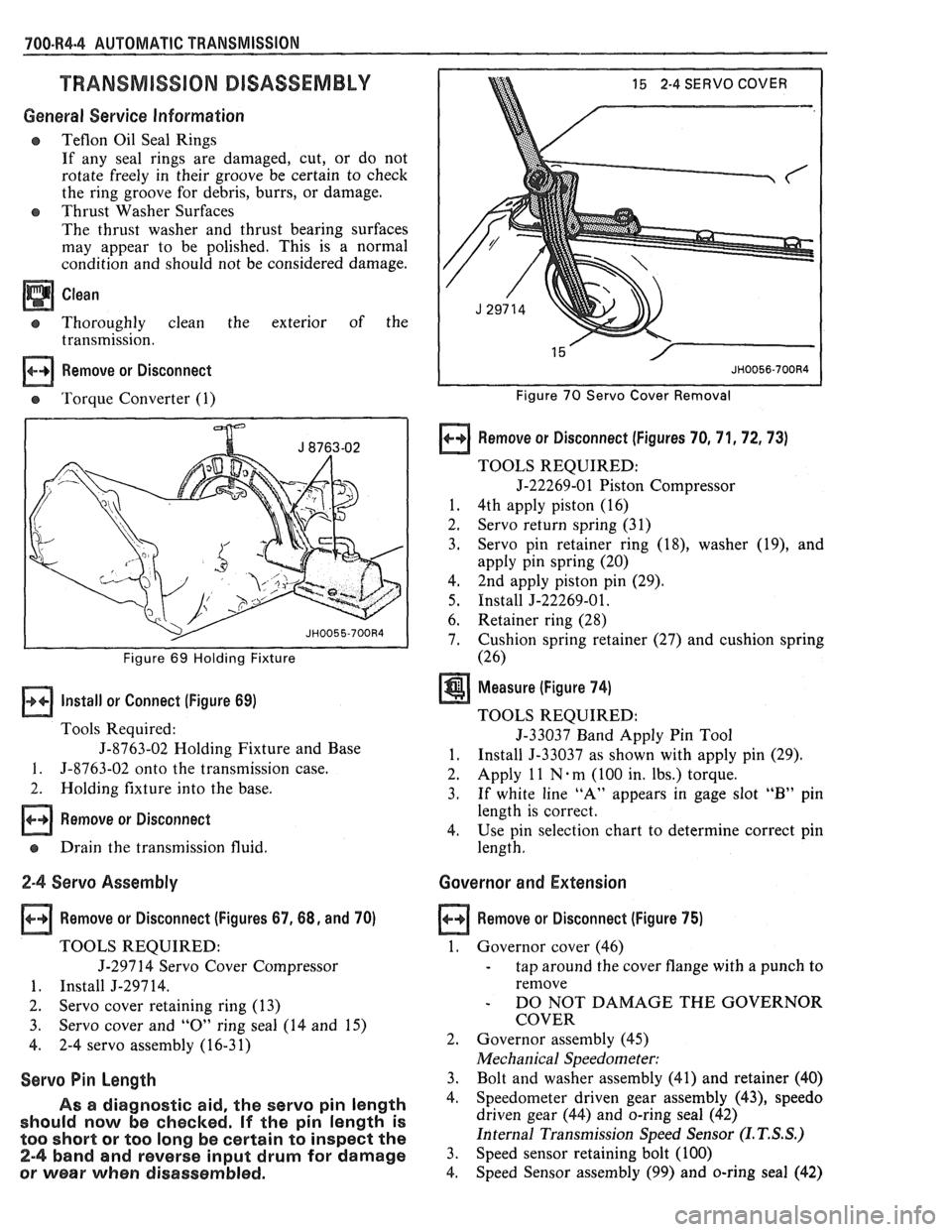
700.R4.4 AUTOMATIC TRANSMISSION
TRANSMISSION DISASSEMBLY
General Service Information
e Teflon Oil Seal Rings
If any seal rings are damaged, cut, or do not
rotate freely in their groove be certain to check
the ring groove for debris, burrs, or damage.
s Thrust Washer Surfaces
The thrust washer and thrust bearing surfaces
may appear to be polished. This is a normal
condition and should not be considered damage.
Thoroughly clean the exterior of the
transmission.
Remove or Disconnect
e 'Torque Converter (1)
I I Figure 69 Holding Fixture
Install or Connect (Figure 69)
Tools Required:
J-8763-02 Holding Fixture and Base
1. 5-8763-02 onto the transmission case.
2. Holding fixture into the base.
Remove or Disconnect
e Drain the transmission fluid.
2-4 Servo Assembly
Remove or Disconnect (Figures 67,68, and 70)
TOOLS REQUIRED:
J-297 14 Servo Cover Compressor
1. Install J-29714.
2. Servo cover retaining ring (13)
3. Servo cover and
"0" ring seal (14 and 15)
4. 2-4 servo assembly (16-31)
Servo Pin Length
As a diagnostic aid, the servo pin length
should now be checked.
If the pin length is
too short
or too long be certain to inspect the
2-4 band and reverse input drum for damage
or wear when disassembled.
15 2-4 SERVO COVER
Figure 70 Servo Cover Removal
Remove or Disconnect (Figures 70, 71,72,73)
TOOLS REQUIRED:
5-22269-01 Piston Compressor
1. 4th apply piston (16)
2. Servo return spring (31)
3. Servo pin
retainer ring
(18), washer (19), and
apply pin spring (20)
4, 2nd apply piston
pin (29).
5. Install J-22269-01.
6. Retainer ring
(28)
7. Cushion spring
retainer (27) and cushion spring
(26)
Measure (Figure 74)
TOOLS REQUIRED:
5-33037 Band Apply Pin Tool
1. Install 5-33037 as shown with apply pin (29).
2. Apply
1 1 N . m
(100 in. lbs.) torque.
3. If white line "A" appears in gage slot "B" pin
length is correct.
4. Use pin selection chart to determine correct pin
length.
Governor and Extension
Remove or Disconnect (Figure 75)
1. Governor cover (46)
- tap around the cover flange with a punch to
remove
- DO NOT DAMAGE THE GOVERNOR
COVER
2. Governor assembly (45)
Mechanical Speedometer:
3. Bolt and washer assembly (41) and retainer (40)
4. Speedometer driven gear assembly (43), speedo
driven gear (44) and o-ring seal (42)
Internal Transmission Speed Sensor
(I. T. S.S.)
3. Speed sensor retaining bolt (100)
4. Speed
Sensor assembly
(99) and o-ring seal (42)
Page 1056 of 1825
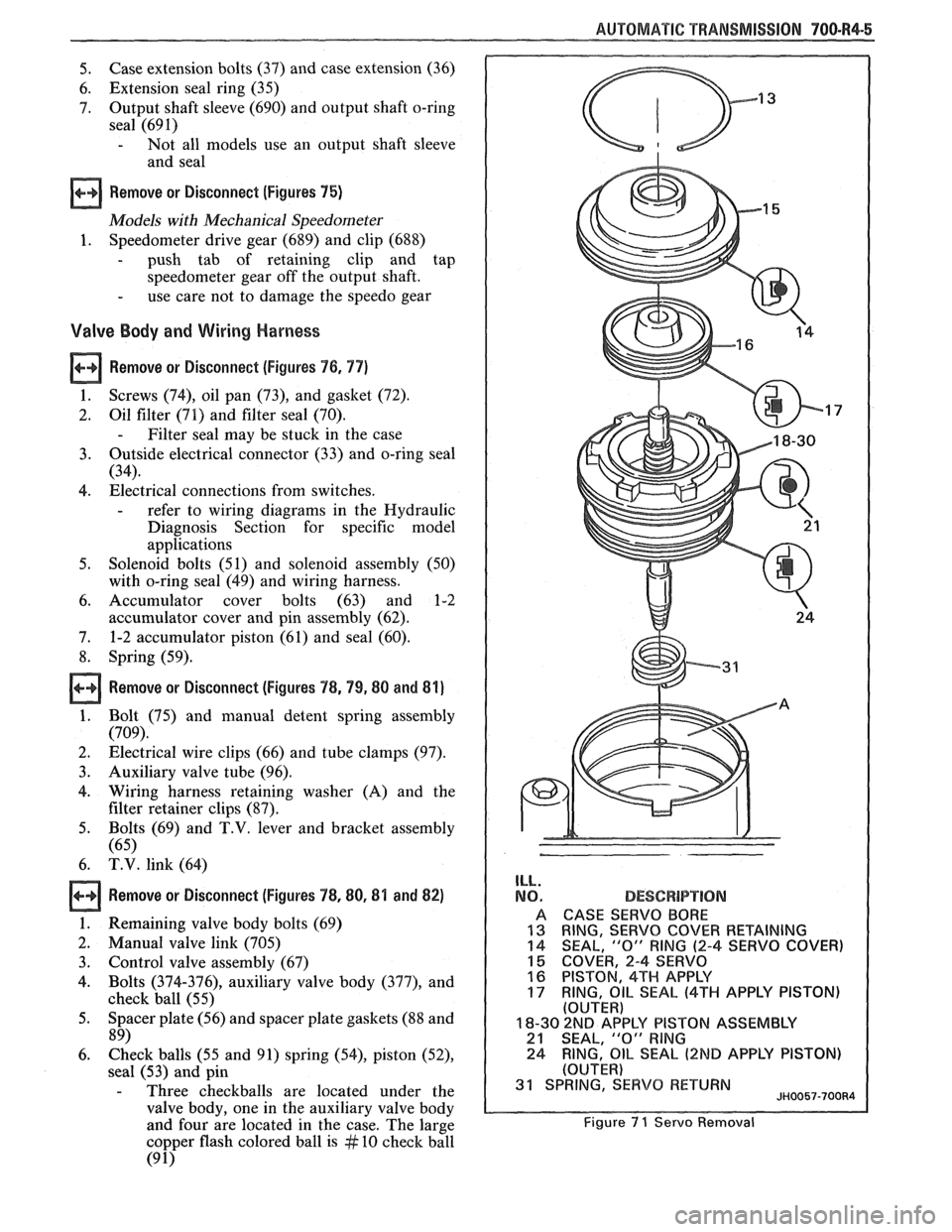
AUTOMA"PI&: TRANSMISSION 780-R4-5
5. Case extension bolts (37)
and case extension (36)
6. Extension seal ring (35)
7. Output
shaft sleeve (690) and output shaft o-ring
seal (691)
- Not all models use an output shaft sleeve
and seal
a Remove or Disconnect (Figures 75)
Models with Mechanical Speedometer
1. Speedometer drive gear
(689) and clip (688)
- push tab of retaining clip and tap
speedometer gear off the output shaft.
- use care not to damage the speedo gear
Valve Body and Wiring Harness
Remove or Disconnect (Figures 76, 77)
1. Screws (74), oil
pan (73), and gasket (72).
2. Oil filter
(71) and filter seal (70).
- Filter seal may be stuck in the case
3. Outside
electrical connector (33) and o-ring seal
(34).
4. Electrical connections from switches.
- refer to wiring diagrams in the Hydraulic
Diagnosis Section for specific model
applications
5. Solenoid bolts
(51) and solenoid assembly (50)
with o-ring seal (49) and wiring harness.
6. Accumulator cover bolts (63) and 1-2
accumulator cover and pin assembly (62).
7. 1-2 accumulator piston (61) and seal (60).
8. Spring (59).
Remove or Disconnect (Figures 78,99,88 and 81)
1. Bolt (75) and manual detent spring assembly
(709).
2. Electrical wire clips (66) and tube clamps (97).
3. Auxiliary valve tube (96).
4. Wiring harness retaining washer (A) and the
filter retainer clips
(87).
5. Bolts (69) and T.V. lever and bracket assembly
(65)
6. T.V. link (64)
Remove or Disconnect (Figures 78,88,8'1 and 82)
1. Remaining valve body bolts (69)
2. Manual valve link (705)
3. Control valve assembly (67)
4. Bolts
(374-376), auxiliary valve body (377), and
check
ball (55)
5. Spacer plate (56) and spacer plate gaskets (88 and
89)
6. Check balls (55 and 91) spring (54), piston (52),
sea1 (53) and pin
- Three checkballs are located under the
valve body, one in the auxiliary valve body
and four are located in the case. The large
copper flash colored ball is
# 10 check ball
(9 1)
ILL.
NO.
A
13 14
15 16
17
DESCBPlPT!ON
CASE SERVO BORE
RING,
SERVO COVER RETAINING
SEAL, "0" RING (2-4 SERVO COVER)
COVER, 2-4 SERVO
PISTON, 4TH APPLY
RING,
OIL SEAL (4TH APPLY PISTON) (OUTER)
18-30 2ND AP'PLY PISTON ASSEMBLY 21 SEAL, "0" RlNG
24 RING, OIL SEAL (2ND APPLY
PISTON)
(OUTER) 31 SPRING, SERVO RETURN JH0057-700R4
Figure 7 1 Servo Removal
Page 1057 of 1825
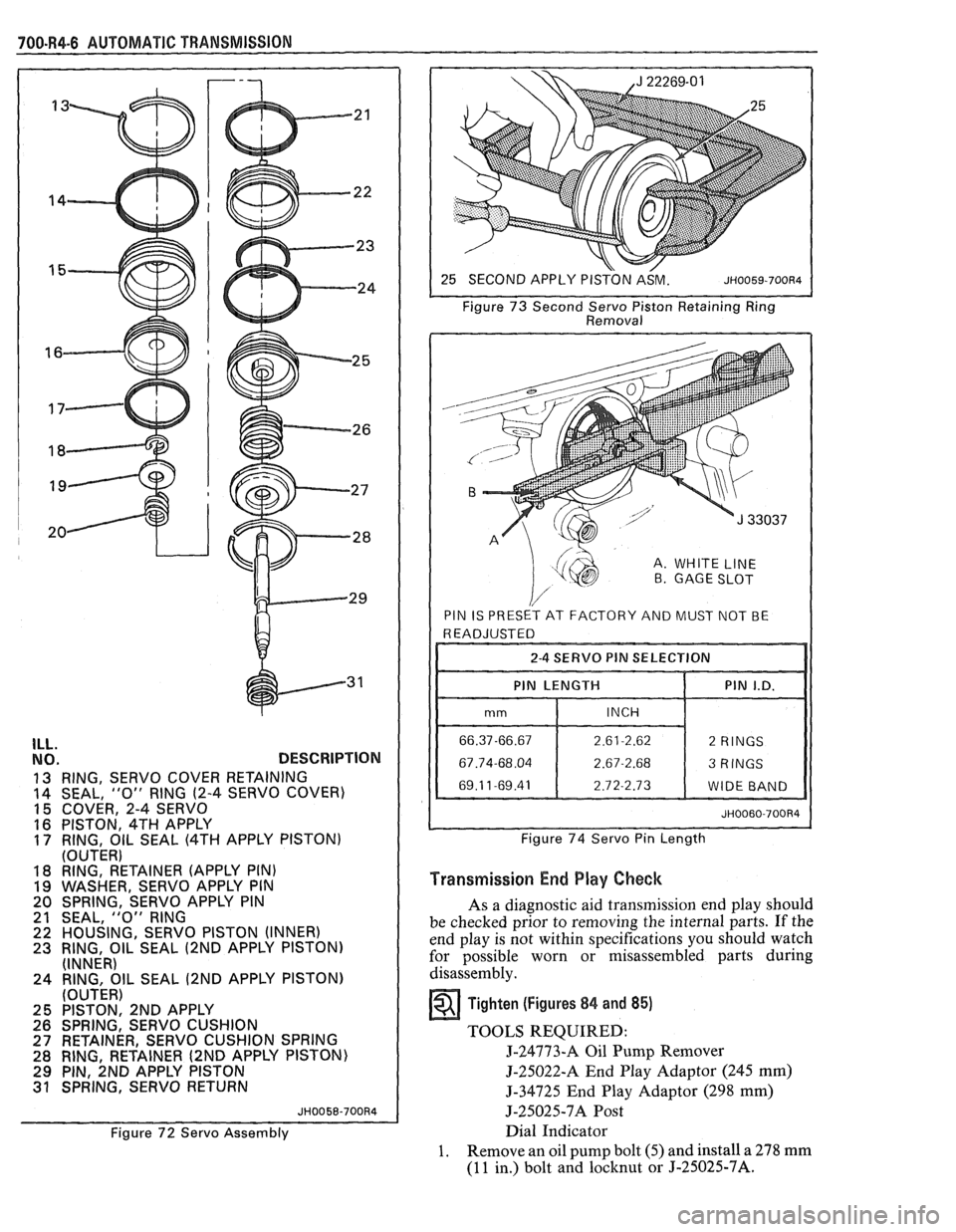
700.R4-6 AUTOMATIC TRANSMISSION
ILL. NO. DESCRIPTION
13 RING, SERVO COVER RETAINING
14 SEAL, "0" RING (2-4
SERVO COVER)
15 COVER, 2-4 SERVO
16 PISTON, 4TH APPLY 17 RING, OIL SEAL (4TH APPLY PISTON)
(OUTER)
18 RING, RETAINER (APPLY PIN)
19 WASHER, SERVO APPLY PIN
20 SPRING, SERVO APPLY PIN
21 SEAL,
"0" RING 22 HOUSING, SERVO PISTON (INNER) 23 RING, OIL SEAL (2ND APPLY PISTON)
(INNER)
24 RING, OIL SEAL
(2ND APPLY PISTON)
(OUTER)
25 PISTON, 2ND APPLY
26 SPRING, SERVO CUSHION
27 RETAINER, SERVO CUSHION SPRING
28 RING, RETAINER
(2ND APPLY PISTON)
29 PIN, 2ND APPLY PISTON 31 SPRING, SERVO RETURN
JH0058-700R4
Figure 72 Servo Assembly Figure
73 Second
Servo Piston Retaining Ring
Removal
A. WHITE LINE B GAGE SLOT
PIN IS PRESET AT FACTORY AND MUST NOT BE
I I 2-4 SERVO PIN SELECTION I I
I I PIN LENGTH 1 PIN I.D. 11
Figure 74 Servo Pin Length
Transmission End Play Check
As a diagnostic aid transmission end play should
be checked prior to removing the internal parts. If the
end play is not within specifications you should watch
for possible worn or misassembled parts during
disassembly.
Tighten (Figures 84 and 85)
TOOLS REQUIRED:
J-24773-A Oil Pump Remover
5-25022-A End Play Adaptor (245 mm)
5-34725 End Play Adaptor (298 mm)
5-25025-7A Post
Dial Indicator
1. Remove an oil pump bolt (5) and install a 278 mm
(11 in.) bolt and locknut or J-25025-7A.